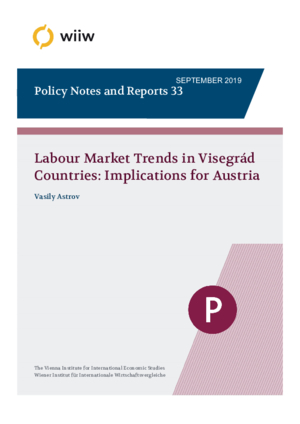Labour Market Trends in Visegrád Countries: Implications for Austria
wiiw Policy Note/Policy Report No. 33, September 2019
16 pages including 4 Tables and 11 Figures
Economic developments in the four Visegrád countries – the Czech Republic, Hungary, Poland and Slovakia – will be viewed against the background of secular trends of population ageing and, in some cases, outright population decline. Under plausible assumptions, these trends will persist over the next few decades, as low birth rates and rising mortality rates – reinforced by outward net migration in the case of Poland – will result in the working-age populations shrinking further. So far, the economic effects of the reduced labour supply in the Visegrád countries have been largely positive: it has been a major factor behind the dramatic decline in unemployment over the past few years. However, growing labour shortages – unless offset by increased automation – might become a constraint on the economic growth of the Visegrád countries in the near future.
It was only after a considerable time lag that the decline in labour supply started to translate into an improvement in the bargaining power of workers and a corresponding sustained real wage growth. Until about 2013, these were largely offset by institutional factors, namely labour market liberalisation and fiscal austerity measures implemented in the aftermath of the global financial crisis, resulting in the stagnation of real wages over a protracted period of time. It was not until 2013 that real wage growth in the Visegrád countries finally gained momentum, crucially helped by a profound turnaround in economic policies under the newly formed ‘populist’ governments which revoked some of the liberal economic reforms initiated by their predecessors (especially in Hungary and Poland). The marked growth in real wages observed over the past few years has hardly eroded the competitiveness of the Visegrád countries’ economies which all possess a strong export sector and continue recording solid trade surpluses. At the same time, it has been the main factor behind the growth of private consumption – and ultimately GDP growth.
The implications of these developments for Austria are likely to be two-fold. On the one hand, the above-average economic growth in the Visegrád countries is welcome news for Austria as it will offer more trade and investment opportunities for Austrian companies. The track record of increased economic cooperation with these countries so far has been, by and large, positive for Austria. On the other hand, the shrinking working-age population in the Visegrád countries and their ongoing catching-up, inter alia in terms of wages and social benefits, imply that labour migration flows from these countries to Austria, which has been sizeable up to now, will likely subside, aggravating the problem of labour and skills shortages in Austria.
Measures offsetting the rising labour and skill shortages in Austria could include, for instance, training programs and apprenticeships, supported by fiscal measures such as tax benefits and targeted subsidies. In the longer term, mitigating labour force shortages in Austria would require policies such as improving training in technical and craft occupations as well as subsidising investments in labour-saving technologies which could offset the effects of a shrinking working-age population on economic growth.
Keywords: demographic trends and forecasts, labour supply, wage and income policies
JEL classification: J11, J2, J31, J38
Countries covered: Austria, Czechia, Hungary, Poland, Slovakia, Visegrad countries
Research Areas: Labour, Migration and Income Distribution
